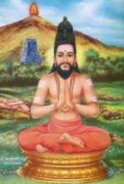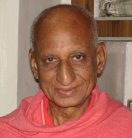

THE ESOTERIC
KANDAR ANUBHUTI
OR
THE SECRET TEACHING ON
GOD-EXPERIENCE
(A Treatise on Adwaitic Realization)
OF
SAINT ARUNAGIRINATHAR

 |  THE ESOTERIC KANDAR ANUBHUTI OR THE SECRET TEACHING ON GOD-EXPERIENCE (A Treatise on Adwaitic Realization) OF SAINT ARUNAGIRINATHAR |  |
 | by N.V. Karthikeyan |  |
| verses contents 42 43 44 45 46 47 48 49 50 51 this verse in PDF version (6 parts) p-1 p-2 p-3 p-4 p-5 p-6 complete download of this book |
VERSE-49 தன்னந்தனி நின்றது தான் அறிய இன்னம் ஒருவர்க்கு இசைவிப்பதுவோ மின்னும் கதிர்வேல் விகிர்தா நினைவார் கின்னம் களையும் க்ருபைசூழ் சுடரே.Thannam thani ninrathu thaan ariya, Innam oruvarkku isai-vippathuvo Minnum kathivel vikirthaa ninaivaar, Kinnam kalaiyum krupai soozh sudare. That which Is by Itself, by oneself is It to be realised; Commentary This is an extraordinary verse revealing the nature of the Absolute Reality and the direct way of attaining It. Here is the Jivanmukta's/Arunagirinathar's instruction to aspirants that an all-inclusive meditation on God or Reality is the royal means to the realisation of the Absolute (or God-experience) which cannot be related but has to be experienced by oneself. Such verses clearly confirm that Arunagirinathar was a saint of the highest Advaitic realisation. Each verse in the concluding portion of Kandar Anubhuti excels the other in profundity and spiritual depth. They reveal Saint Arunagirinathar's extraordinary capacity to express the highest Vedantic truths in simple terms and yet, convey their precise imports. Here is yet another verse of such a rare caliber. Ekam-eva Advitiyam Brahma - "One without a second is Brahman," says the Veda. This is what Arunagirinathar conveys by the phrase "Thannan Thani Ninra Adhu" in this verse. In verse 28, he said, "Verum Thaanaai Nilai Ninra Adhu", which also conveys the same meaning. "Thani" means alone; and the phrase "Thannan Thani" is not a mere repetition of words, but a purposeful composition to convey the Upanishadic import. When we are in a forest or secluded place, away from people, we are alone. But, it does not mean that there are no other persons in the world. People are there, though not within our visibility. But Reality (Brahman) is not alone in this sense. It is Alone, all by Itself; and there is nothing second to It. Hence, It is described as "Thannan Thani", and not merely as "Thani" - One Alone, and not as one; because one implies two, three, etc. also. It is One Alone without a second - Ekam (One) eva (only) Advitiyam (secondless) Brahma (is Brahman) - Thannan Thani (Alone, by itself) Ninra (which is) Adhu (That - Brahman). Now, a doubt may arise in our minds. If Brahman alone exists and there is nothing second to It, what is it that we see as the world? Vedanta boldly declares that the world is a mere appearance, and that, too, a phase of Reality Itself; it does not independently "exist" as a second entity other than That. It has no existence or reality of its own. Its existence is the existence-aspect of Brahman. That we see a thing does not mean that it has an existence of its own. There are many instances in our day-to-day life which can illustrate this. Take the case of the ocean and the waves. The ocean is a huge mass of water and the wave a crest of water in the ocean. Now, is there anything in the wave other than water? No. The wave is water, is the ocean. Only we call it a wave, due to our perception being limited to a part and not the whole, to the appearance and not the essence. So is the case with the world. It is an appearance, whose reality is Brahman. We are deluded by the variegated names and forms, which are like waves in the ocean of Satchidananda. Just as the wave is a phase of the ocean, so is the world an aspect of Brahman (Reality). Not only the "other" objects of the world are like waves but we ourselves, too, are like waves. Our perception of the world is like one wave beholding another, which both are but phases of the same mass of water. Now, if a wave wants to know the ocean, what has it to do? So long as it is a wave, it cannot know the ocean; because it is so small and the ocean so vast. The wave cannot expand itself to the extent of the ocean. But there is a way to it. The wave is, in essence, water and the ocean, too, is nothing but water. Both are of the same substance. Hence, when the wave just subsides, it becomes the ocean, it is the ocean; and it knows the ocean. And, to the ocean there are no waves; they are the ocean itself. So is the case with the Jivas and the world. The Jiva is nothing but a crest of consciousness in the ocean of Satchidananda. The world, too, is nothing but the Sat (existence) aspect of Brahman. Their essence, their reality is Brahman. When the Jiva (or individuality) subsides, like the wave, Satchidananda alone is and It knows Itself. Knowing the Absolute is, therefore, being the Absolute Itself. Brahmavid Brahmaiva Bhavati - "the Knower of Brahman becomes Brahman", says the scripture. Hence, Arunagirinathar says, "Thaan (Adhuvaaga Irundhu) Ariya." The way to the Infinite is, therefore, not extension but extinction of individuality (Jivatva). The essence in the Jiva, which is also the essence of the cosmos, which is God, has to know itself by being itself, and not try to know "something else" in which process externalisation is involved. The finite has to relinquish itself in the Infinite, which is its Substratum as well as the Substratum of everything. Hence, That which is One without a second, is to be known by oneself by being It. Except this, there is no other way. Reality has to be experienced by each for oneself. It cannot be explained to others, for want of means of communication. Experiences cannot be related to others. Even ordinary sense-experiences like pleasure, pain, sweetness, beauty, etc., cannot be communicated to others. What to speak of the Experience-Absolute, where the experiencer himself is transformed into the Absolute? Who is to tell, and to whom? Neither "he" is, nor the "other" is, That alone is; It has to be experienced by each one for oneself, by being It Itself. What, then, is the use of the realisation of the illumined souls, saints and sages, if their experience is not going to be of any help to others, as they cannot communicate it to others -- may be our pertinent doubt. It is true that they cannot communicate their experiences, but they can, and they do, show us the way to attain that experience, because they have trodden the path. Though the experience of the sweetness of sugar-candy had by one cannot be communicated to another, yet he can show us the means of obtaining it and tasting it for ourselves by which we, too, can have the same experience. This is what the Saint does in the latter half of the verse. Meditation is the royal road to the Experience, affirms Arunagiri. Meditation on what? On the Vel or Murugan, which are identical. Now, what is the method of meditation? As the means determine the end, the Goal being the realisation of the non-dual Brahman as mentioned in the earlier part of the verse, the meditation suggested by Arunagirinathar to achieve it is a masterly one. But the technique of meditation hinted at is so secretly hidden that it is difficult to extract it from the verse and it is even likely to go unnoticed. Arunagirinathar addresses the Lord as "Minnum Kathir-Vel Vigirdhaa", in which is the clue to meditation hidden. The nature of the Lord (Reality) is revealed in this phrase, a correct understanding of which is itself the technique of meditation. Let us first see the plain meaning of the phrase, which is, "O Lord of varied forms, with the lightning luminous-Vel." The Vel is Wisdom-Vel; Kathir-Vel. It shines, like the sun, by itself; It is self-luminous. It also flashes forth wisdom (light), like a lightning; It is Minnum Kathir-Vel. The Lord is many-formed. He is the Baala-Murugan who imprisoned Brahma and incidentally gave Upadesa on Pranava (OM) to Lord Siva (verse 36); He is the Lord with the six-faces (Shanmukha); He assumed many forms in the battle with the Asura Surapadman; He took the forms of a hunter, tree, old man, etc., to test and accept Valli; and He appears in the form in which His devotees worship (or meditate on) Him. Thus, He has numerous forms. These are the simple and plain meanings of the phrase. But it has a deeper significance which gives the clue to right meditation. The Vel, as we have seen in many earlier verses, is the Absolute Consciousness. It is the Atman (Brahman). What is its nature? It is self-luminous; it is Kathir-Vel. It is the unchanging Reality, the Substratum of everything. It is not merely the Kathir-Vel; it is also "Minnum", i.e., "twinkling" or "flashing". It not only shines as the Absolute Consciousness but also it twinkles as the innumerable Jivas. The Jivas are the flashes or reflections of the light of the Atman in the intellects. Not merely this. The Lord is also of forms varied; He is Vigirdhan. Whatever we perceive are His forms only. In verse 51 also, Arunagirinathar says, "O Lord who comes as all forms (Uruvaai) and as all without form (Aruvaai), etc." He Himself appears as all these names and forms, which have no reality in them apart from the reality (or existence) of the Absolute. "He it is that as an old man totters with a stick, thus, deceiving the human eye, for He is all things," says the Upanishad. Thus, the Kathir-Vel (Absolute Reality) appears ("twinkles" or Minnum) as the Jivas from one aspect and as the vast creation of forms varied (Vigirdhaa) from the other. How beautifully and aptly has Arunagirinathar composed the phrase with "Kathir-Vel" in the middle and "Minnum" and "Vigirdhaa" on either side of it, to show that the latter are the two aspects of the Kathir-Vel which is their Substratum - the ever-shining, self-luminous Reality. The declaration of the Upanishads that this visible universe and the Jivas are none other than (phases of) Brahman Itself, as was explained earlier in this verse, is revealed and confirmed by Arunagirinathar in this phrase "Minnum Kathir-Vel Vigirdhaa". It will, thus, be seen that the visible world, the individual Jivas, and the Absolute Reality are nothing but He (or the Vel). The Absolute which is what really is, is also what we are, and is also what we see. There is nothing other than the Great Reality. Everything is a phase of It, as the waves, ripples, etc., are of the ocean. This is the secret of meditation prescribed by the Saint to attain the Supreme Reality, which is One without a second (Thannan Thani Ninra Adhu). Those who meditate thus (Ninaivaar), their miseries the Lord destroys (Kinnam Kalaiyum). The greatest of all miseries is that of Samsara (transmigration) - the endless cycle of birth and death. This is overcome only when one knows the Supreme by being It. How can one be freed from the need to be reborn so long as one is a limited being? The limited cannot rest at peace as long as it is separated from the Unlimited, as long as it does not feel and realise its oneness with the Limitless. The river cannot be at rest unless and until it reaches the ocean and be the ocean. The child cannot be cajoled with anything except its mother's lap. The Jiva cannot escape transmigration, cannot but be tossed about by its own Karmas (which become inevitable on account of its limited consciousness which makes it feel that there is something outside it with which it has to establish relations), so long as it does not realise its identity with what is. The false notion of individuality (or separatist existence) is the source of all miseries, which is put an end to by the most potent weapon of meditation on Reality - as the Absolute and the relative; as the Invisible and the visible; as Consciousness and matter; as the self-luminous, twinkling Vel and Lord Murugan of forms varied; as Minnum Kathir-Vel Vigirdhaa - on what Is. If one is earnest and sincere in this meditation, success is certain, assures Arunagirinathar. Because, he adds, the Lord is an embodiment of grace and compassion. He is the grace-overflowing, the grace-shedding Flame (Krupai Soozh Sudar). "Sudar" means flame, resplendence, effulgence, Jyoti - Atma Jyoti. It is Chaitanya (or Consciousness), the Light that shines steadily - the Kutastha Atman. In the word "Sudar," is implied steadiness (or unflickering nature). It is, therefore, the Kutastha Chaitanya, not the Jiva-consciousness which constantly changes. Further, this Flame is grace-surrounded or grace-emitting (Krupai Soozh). That it is surrounded by (or that it sheds) grace shows that it itself is a mass of grace. The sun which is a mass of light sheds light. As rays of light emanate from the sun, so also rays of grace overflow from the Lord who is an embodiment of grace. What we receive is but an infinitesimal part of the grace that comes from Him. But that is more than enough to destroy the misery of Samsara and illumine us. The phrase "Krupai-Soozh Sudar" also provides a clue to meditation. It is meditation on the Atman (Sudar) which is a mass of Light, blissful in nature and grace overflowing. Such a meditation will put an end to all miseries. Thus, the two phrases "Minnum Kathir-Vel Vigirdhaa" and "Krupai Soozh Sudar" beautifully suggest the highest types of meditation to attain the Undivided Existence-Consciousness-Bliss Absolute. If the Lord is an embodiment of compassion, a grace-mass, why should He remove the miseries of only those who think of Him and not of all? Fire has the property to burn, but it does not mean it will burn any object, anywhere. It will burn only those that are offered into it, with which it comes into contact. The Ganga purifies the sins of only those that take a dip in it. The sun gives light. But if one remains in a closed room (or wraps oneself up) and would not expose oneself, what can the sun do? Even so, the Lord is compassionate, no doubt, but one should open one's heart to Him, so that His grace may be felt by one. One should "want" God; then God gives Himself to him. He does not want rich presents, high learning, or a sharp intellect. He wants that we want Him. Selfless service with the feeling of God's presence, study of scriptures that extol His glories, Japa, Kirtan, charity, meditation, etc., are all different practices to open one's heart to the Divinity that dwells within, to that Resplendence which is overflowing with grace. Thus, to think of the Lord unceasingly, depending on Him for one's existence and wanting Him truly will destroy one's miseries and draw His divine grace which will manifest within as the Resplendent Vel (or Pure Consciousness) - an experience which each one has to have for oneself and cannot be related to another. |
| contents 42 43 44 45 46 47 48 49 50 51 this verse in PDF version (6 parts) p-1 p-2 p-3 p-4 p-5 p-6 |
| ... www.kaumaram.com ... The website for Lord Murugan and His Devotees முகப்பு கௌமாரம் அட்டவணை மேலே தேடல் home Kaumaram contents top search |
Kaumaram.com is a non-commercial website. This website is a dedication of Love for Lord Murugan. Please take note that Kaumaram.com DOES NOT solicit any funding, DIRECTLY or INDIRECTLY. |